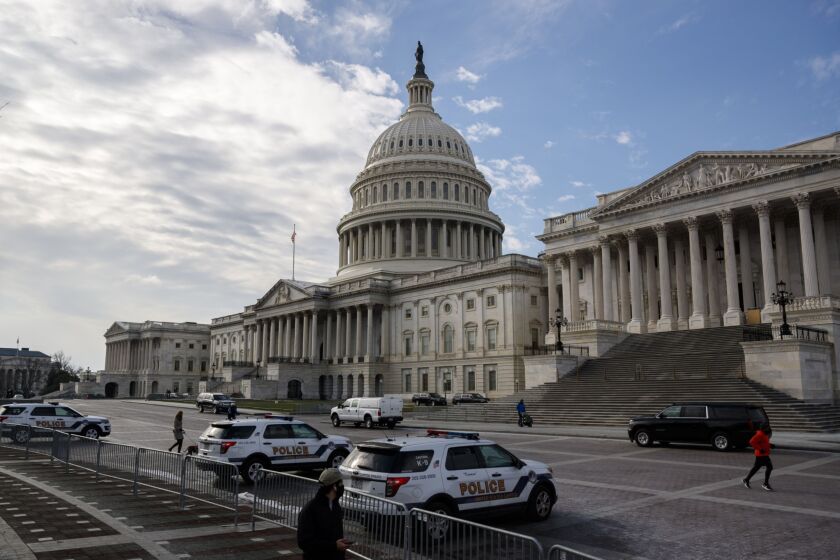The House and Senate are set to vote Monday on $900 billion in pandemic relief aimed at shoring up the U.S. economic recovery into the early spring, combined with $1.4 trillion to fund regular government operations for the rest of the fiscal year.
The massive legislation runs 5,593 pages and includes other tax, energy and national-security provisions that lawmakers agreed to pass before the end of the year.
Noah Gold is the general counsel and head of public policy of Prism Data, a cash flow underwriting infrastructure and analytics platform. Prior to joining Prism, he was the general counsel of Petal, a fintech credit card company. Before that, he was the assistant general counsel of a leading e-commerce software platform, and prior to that Noah previously practiced law at Paul, Weiss, Rifkind, Wharton & Garrison LLP.
Jason Rosen is founder and CEO of Prism Data, a cash flow underwriting infrastructure and analytics platform. Prior to founding Prism, Jason was co-founder and CEO of Petal, a fintech credit card company. Jason served on the Consumer Advisory Board of the Consumer Financial Protection Bureau, sat on the Small Business Regulatory Enforcement Fairness Act panel for the Open Banking rulemaking, and is a member of the OCC's Project REACh. Jason previously practiced law at Sullivan & Cromwell and Gunderson Dettmer, where he represented financial institutions, technology companies and venture capitalists. Jason holds a JD from Harvard Law School.
Dev Nag is the founder and CEO of QueryPal. He was previously on the founding team at GLMX, one of the largest electronic securities trading platforms in the money markets. He was also CTO and founder at Wavefront (acquired by VMware) and a senior engineer at Google, where he helped develop the back end for all financial processing of Google ad revenue. He previously served as the manager of business operations strategy at PayPal. He also launched eBay's private-label credit line in association with GE Financial. Dev received a dual-degree B.S. in mathematics and B.A. in psychology from Stanford.
The pandemic relief bill includes help for small businesses, the jobless and direct payments to most Americans. It also provides funding for vaccine distribution, food assistance, tax breaks and money for education and child care.

The provisions aimed at the fallout from the coronavirus represent the second-largest economic rescue package in American history, behind the $1.8 trillion virus relief package that was signed into law just nine months ago. It surpasses the $787 billion stimulus passed in response to the financial crisis in 2009.
Together with the omnibus spending bill, the total package is worth more than $2.3 trillion. Tax benefits included in the bill have yet to be scored.
Main relief components:
- $600 direct payments to most Americans
- $300 a week in extra unemployment benefits through March
- $284 billion for the Paycheck Protection Program that helps small businesses
- $82 billion for K-12 schools and universities
- $69 billion for vaccine development, testing and community health
- $25 billion in rental assistance
- $15 billion for performance venues
- $15 billion in aid for airlines
- $14 billion for public transit
- $13 billion for food-stamp benefits
- $13 billion in aid to farmers and ranchers
- $10 billion for childcare
Here are some highlights of specific provisions:
Direct payments
The bill provides $600 in one-time direct payments to individuals and $600 per child. The payments get phased out for individuals making more than $75,000 or couples making $150,000. Treasury Secretary Steven Mnuchin said the Internal Revenue Service would begin processing payments as soon as next week. The IRS already had set up a system to distribute $1,200 payments in the stimulus bill passed in March.
Several senators, including Missouri Republican Josh Hawley and Vermont Progressive Bernie Sanders, said they wanted larger stimulus payments, but they agreed not to object to a final deal with the smaller amount. Progressive Democrats in the House have started calling these “survival checks.”
Jobless benefits
Federal unemployment insurance benefits will be extended for 10 weeks through mid-March, with a $300 supplement payment each week, similar to the extra $600 supplement that expired at the end of July.
It includes people receiving state unemployment benefits as well as those receiving Pandemic Unemployment Assistance, a program that provided jobless benefits to those not traditionally eligible, like gig workers and the self-employed. Without congressional action, the program was on track to expire at year-end, which would have caused millions of Americans to lose their jobless benefits.
Pandemic Emergency Unemployment Compensation, which provided up to 13 additional weeks of jobless benefits to those who had exhausted their regular state benefits, was extended as well.
Unlike stimulus payments and forgiven PPP loans, which aren’t subject to federal taxes, unemployment insurance recipients must pay income taxes on their jobless benefits. Many states don’t automatically withhold taxes when they distribute those payments, so recipients will owe those taxes when they file their tax returns next spring.
Companies, airlines
The aid package includes $284 billion for the Paycheck Protection Program that was created in the Cares Act. That program’s loans to firms with fewer than 500 employees can be fully forgiven if companies keep people on their payroll.
The legislation clarifies that business owners can write off expenses paid for with forgiven PPP loans, giving small companies a tax break that could amount to more than $100 billion. The legislation would override an IRS decision that said businesses couldn’t claim deductions on costs, such as rent and wages, paid for with tax-free PPP money.
It also includes includes $15 billion to reinstate payroll reimbursements to airlines, which expired two months ago, as well as $1 billion for airline contractors.
Tax breaks
The legislation includes a priority for President Donald Trump: an expansion of the business-meals deduction. Economists have said the change would do little immediately to help struggling restaurants.
It also includes a renewal of the employee retention tax credit for businesses that keeps workers on their payrolls. The break gives companies an additional incentive to keep people employed as many firms still face revenue downturns but have run out of PPP money or never qualified for it.
The package makes changes to the earned income tax credit and the child tax credit to make it available to people who lost wages or jobs during the pandemic, as well as an expanded Low Income Housing Tax Credit to boost construction of housing for low-wage families.
The legislation would make permanent an excise tax break for beer brewers, wine makers and distillers. In addition, other expiring tax credits, including some for mortgage interest premiums and tax credits to help businesses in low-income communities.
Housing, education and more
The measure contains $25 billion for emergency rental assistance, and it extends the CARES Act’s eviction moratorium until Jan. 31.
It also calls for $7 billion in spending on broadband internet, including $3.2 billion to help poor households pay for the service and $1.9 billion to boost security by removing gear from equipment providers such as Huawei Technologies Co.
Other key funding provisions include funds for virus testing, tracing and vaccine development and distribution. It also has $82 billion for education funding, as well as $10 billion to support childcare providers, $15 billion for entertainment venues and $13 billion for nutrition assistance. The bill would convert a $10 billion loan for the U.S. Postal Service to a grant.
Non-pandemic measures
The legislation includes $1.4 trillion in regular appropriations to keep the government operating through the end of fiscal 2021 on Sept. 30. A last-minute deal kept $12.5 billion for Veterans Affairs health funding under the total spending budget cap.
Lawmakers settled on nearly $1.4 billion for border-wall construction and related spending, short of Trump’s request for nearly $2 billion. His $5 billion ask for fiscal 2019 led to the longest shutdown in the country’s history, but he hasn’t had a standoff with lawmakers over wall funding since he circumvented Congress by using military funds to build additional fencing.
The spending package also includes the long-standing Hyde amendment, which bars federal funds for most abortions, and the Helms amendment, which bars the use of foreign assistance funds for abortions. Congressional Democrats have said they want to remove the Hyde amendment from spending bills starting in fiscal 2022, when a Democrat will be in the White House. President-elect Joe Biden has said he also opposes the Hyde amendment.
There are a number of so-called “riders” that aren’t related to the pandemic or the 12 appropriations bills that make up the spending omnibus. These include everything from a bill creating Smithsonian museums dedicated to women’s history and the American Latino to technical corrections to the U.S.-Mexico-Canada trade agreement.
One of those riders is the long-discussed legislation to protect patients with health insurance from “surprise” medical bills in most emergency situations, including air ambulance rides. Patients also wouldn’t have to pay bills received more than 90 days after a visit, and health plans and providers would have to provide patients with more information on their networks and costs.
The final legislation also calls for the U.S. to join other nations in phasing out hydrofluorocarbons used in air conditioning and refrigeration systems. While hydrofluorocarbons aren’t nearly as bad for the ozone layer as chlorofluorocarbons, the chemical they were designed to replace, they still have hundreds to thousands of times the heat-trapping power of carbon dioxide.
The bill includes a reauthorization of the Water Resources Development Act that deals with water-related infrastructure. It also extends tax credits for renewable energy projects, including wind and solar production.
The bill reforms the way the Federal Aviation Administration certifies aircraft, a move prompted by the failures of the Boeing 737 Max plane.
The legislation would allow the secretaries of Homeland Security and Labor to increase the number of H-2B visas for workers in meatpacking, landscaping and construction.
The catch-all bill alters pipeline safety regulations, reforms the federal student aid application, institutes regulations for horse racing and resolves terrorism claims against Sudan, among hundreds of smaller provisions tucked inside.
It would also give civilian federal workers a 1% raise, as well as a 3% raise for the military, but no pay increase for the lawmakers who will be voting on the final bill.
— With assistance from Alan Levin, Ari Natter, Steven T. Dennis and Jack Fitzpatrick



